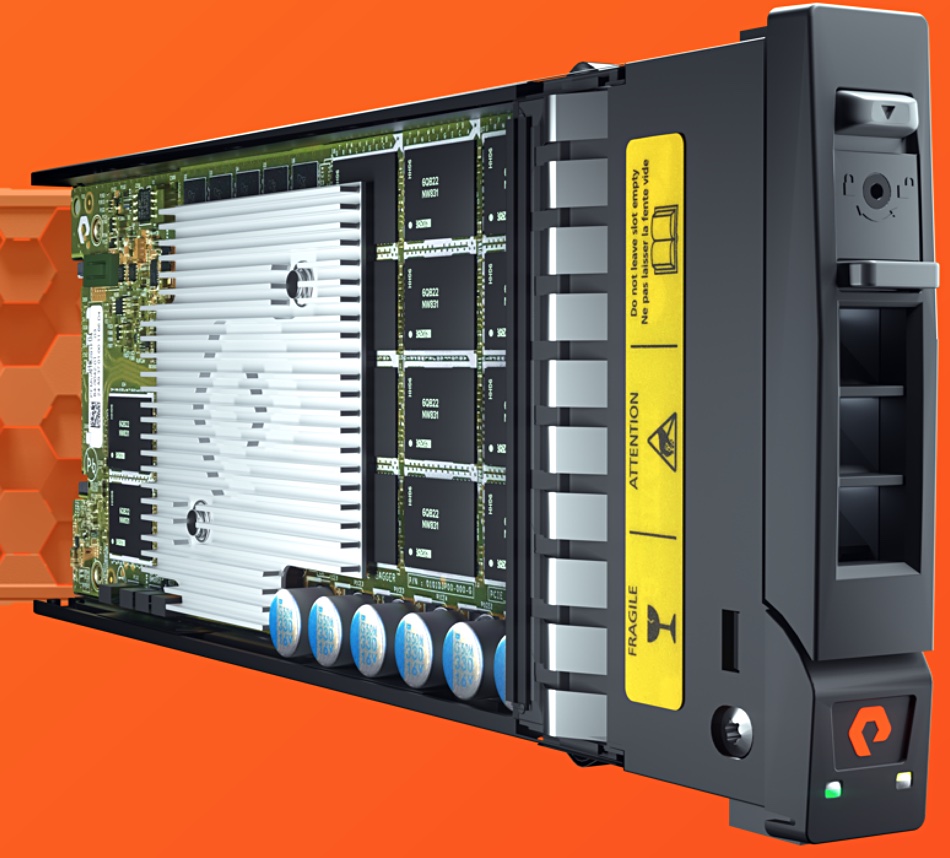Pure Storage thinks the second generation of the FlashArray//C, launched today, is a hybrid flash-disk storage killer.
Updated 26 August 2020 with Matt Kixmoeller comment
The FlashArray//C is intended for tier 2 workloads such as test and dev, backup and recovery, VMs, email, data repositories and legal archives. With the new upgrade it costs less than enterprise hybrid arrays, Pure claims, and can host all enterprise performance-oriented and capacity-oriented use cases on a single all-flash platform.
Scott Baker, product marketing VP for FlashArray, said: “We’re proud to … make the benefits of flash more accessible for a broader range of use cases at an economic advantage that is sure to make hybrid storage a thing of the past.”
Moving from enterprise disk drive arrays to its all-flash arrays can save multiple racks of disk drives and lower power and cooling costs, according to Alex McMullan, CTO, International at Pure Storage. He told us the array price is under $0.50/raw GB. That means a 1.3 PB gen 2 FlashArray//C would cost less than $650,166.50. On that basis, one with 31 drives and 768TB capacity would be priced under $384,000.

For comparison, a 768TB StorONE mirrored QLC flash (with Optane caching) array is priced at $594,489.00. VAST Data also supplies a QLC flash array, again with Optane caching, and says it has a total cost of acquisition that is equivalent to hard drive-based archive systems. However, the company has published no actual prices. In common with Pure, VAST Data and StorOne argue that all enterprise storage can be consolidated onto a single all-flash system.
Pure’s Matt Kixmoeller, VP for Strategy said in an earnings call: “We now believe it’s substantially less expensive to deploy FlashArray//C than a hybrid array, about 30 per cent cheaper.” This could spark “the final transition to flash [to] happen.”
Spec
The gen 2 FlashArray//C uses higher-capacity NVMe QLC DirectFlash drives than its predecessor – 24.7TB capacity versus 18.3TB. Maximum raw capacity quadruples from 366TB to 1.8PB in 9RU, with effective capacity after data reduction also increasing fourfold from 1.3PB to 5.2PB.
The gen 2 arrays deliver 2ms to 4ms latency with on-drive SLC caching, but no Optane SSD caching, which helps keep the cost down.
The FlashArray//C will get 49TB drive modules later this year, doubling drive capacity and taking maximum effective capacity to 10.4 PB (2.6 PB raw) – eight times more than the gen 1 system. That will be the highest capacity mainstream flash drive. FlashArray// will get also more file storage features later this year, the company says.
The array’s Purity OS software manages quality of service and wear-levelling globally, with granularity down to the die level, to help ensure consistent performance and endurance. As a result, the 24TB drive is more efficient than an equivalent capacity Samsung drive with less over-provisioning, McMullan says.
Array reliability is helped by call-home telemetry down to the flash block level which enables Pure to run predictive analytics and help customers prepare for a drive failure by pre-emptively moving data.
Purity has policy-driven replication, snapshots, and migration between //X and //C arrays and clouds. Customers can use flash for application tiering, disaster recovery, test/dev, and retention.
There is asynchronous replication from //X to //C but not synchronous replication.
FlashArray//C and FlashBlade
The Flash Array//C is positioned under the FlashArray//X, which has faster NAND chips and lower latency and is designed for tier 1 business-critical workloads.
In addition, Pure markets FlashBlade arrays for unstructured data, file and object storage, to optimise infrastructure for analytics purposes
We think there is some overlap between the enlarged FlashArray//C, with 5.9PB effective capacity and FlashBlade, with 3.3PB effective capacity in terms of the general analytics use case. The overlap will increase when FlashArray gets enhanced file storage features later this year. Perhaps the FlashBlade system could use the FlashArray//C drives and get a jump in capacity?








